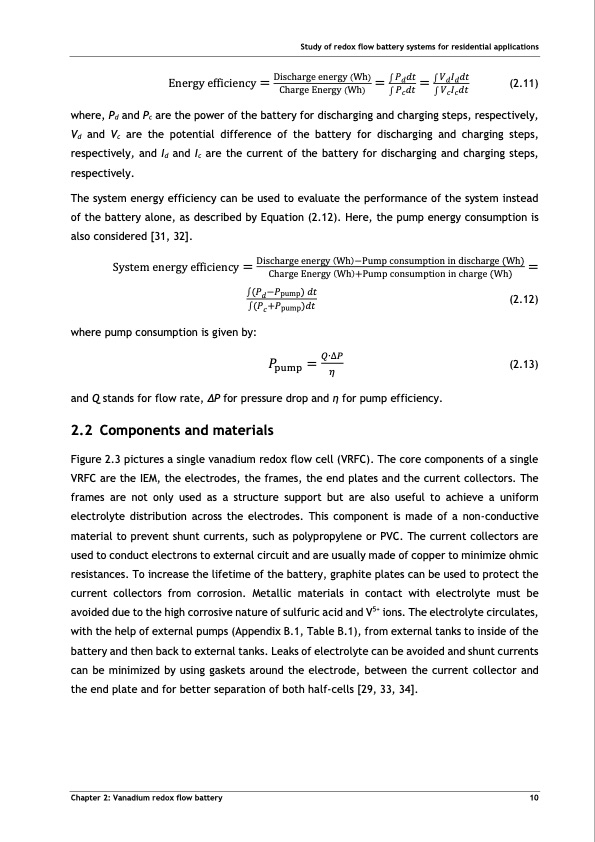
PDF Publication Title:
Text from PDF Page: 021
Study of redox flow battery systems for residential applications Energy efficiency = Discharge energy (Wh) = ∫ 𝑃𝑑𝑑𝑡 = ∫ 𝑉𝑑𝐼𝑑𝑑𝑡 (2.11) Charge Energy (Wh) ∫ 𝑃𝑐𝑑𝑡 ∫ 𝑉𝑐𝐼𝑐𝑑𝑡 where, Pd and Pc are the power of the battery for discharging and charging steps, respectively, Vd and Vc are the potential difference of the battery for discharging and charging steps, respectively, and Id and Ic are the current of the battery for discharging and charging steps, respectively. The system energy efficiency can be used to evaluate the performance of the system instead of the battery alone, as described by Equation (2.12). Here, the pump energy consumption is also considered [31, 32]. System energy efficiency = Discharge energy (Wh)−Pump consumption in discharge (Wh) = Charge Energy (Wh)+Pump consumption in charge (Wh) ∫(𝑃𝑑−𝑃pump) 𝑑𝑡 ∫(𝑃𝑐+𝑃pump)𝑑𝑡 (2.12) (2.13) where pump consumption is given by: and Q stands for flow rate, ∆P for pressure drop and η for pump efficiency. 2.2 Components and materials 𝑃 = 𝑄∙∆𝑃 pump 𝜂 Figure 2.3 pictures a single vanadium redox flow cell (VRFC). The core components of a single VRFC are the IEM, the electrodes, the frames, the end plates and the current collectors. The frames are not only used as a structure support but are also useful to achieve a uniform electrolyte distribution across the electrodes. This component is made of a non-conductive material to prevent shunt currents, such as polypropylene or PVC. The current collectors are used to conduct electrons to external circuit and are usually made of copper to minimize ohmic resistances. To increase the lifetime of the battery, graphite plates can be used to protect the current collectors from corrosion. Metallic materials in contact with electrolyte must be avoided due to the high corrosive nature of sulfuric acid and V5+ ions. The electrolyte circulates, with the help of external pumps (Appendix B.1, Table B.1), from external tanks to inside of the battery and then back to external tanks. Leaks of electrolyte can be avoided and shunt currents can be minimized by using gaskets around the electrode, between the current collector and the end plate and for better separation of both half-cells [29, 33, 34]. Chapter 2: Vanadium redox flow battery 10PDF Image | Tubular Vanadium Air Redox‐flow battery

PDF Search Title:
Tubular Vanadium Air Redox‐flow batteryOriginal File Name Searched:
204521.pdfDIY PDF Search: Google It | Yahoo | Bing
Salgenx Redox Flow Battery Technology: Salt water flow battery technology with low cost and great energy density that can be used for power storage and thermal storage. Let us de-risk your production using our license. Our aqueous flow battery is less cost than Tesla Megapack and available faster. Redox flow battery. No membrane needed like with Vanadium, or Bromine. Salgenx flow battery
| CONTACT TEL: 608-238-6001 Email: greg@salgenx.com | RSS | AMP |